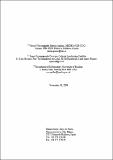Please use this identifier to cite or link to this item:
http://hdl.handle.net/10261/53889Share/Export:
 SHARE SHARE
 CORE
BASE CORE
BASE
|
|
| Visualizar otros formatos: MARC | Dublin Core | RDF | ORE | MODS | METS | DIDL | DATACITE | |

| Title: | Errors in dynamical fields inferred from oceanographic cruise data: Part II. The impact of the lack of synopticity |
Authors: | Gomis, Damià CSIC ORCID; Pascual, Ananda CSIC ORCID; Pedder, Mike A. | Issue Date: | 2005 | Publisher: | Elsevier | Citation: | Journal of Marine Systems 56: 334-351 (2005) | Abstract: | Diagnostic studies of ocean dynamics based on the analysis of oceanographic cruise data are usually quite sensitive to observation errors, to the station distribution and to the synopticity of the sampling. The first two sources have been evaluated in the Part I of this work. Here we evaluate synopticity errors for different sampling strategies applied to simulated unstable baroclinic waves. As suggested in previous studies, downstream and upstream cross-front samplings produce larger errors than along-front samplings. In our particular case study, the along-front sampling results in fractional errors (rms error divided by the standard deviation of the field) of about 15% for dynamic height and more than 50% for relative vorticity and vertical velocity. These values are significantly higher than those obtained in Part I for typical observation errors and sampling limitations (about 6% for dynamic height and between 15 and 30% for geostrophic vorticity and vertical velocity). We also propose and test two methods aimed at reducing the impact of the lack of synopticity. The first one corrects the observations using the quasi-geostrophic tendency equation. The second method combines the relocation of stations (based on a system velocity) and the correction of observations (through the estimation of a growth rate). For the fields simulated in this work, the second method gives better results than the first, being able to eliminate practically all synopticity errors in the case of the along-front sampling. In practice, the error reduction is likely to be less effective, since actual fields cannot be expected to have a system velocity as homogeneous as for the single-mode waves simulated in this work. © 2005 Elsevier B.V. All rights reserved. | Publisher version (URL): | http://dx.doi.org/10.1016/j.jmarsys.2005.02.003 | URI: | http://hdl.handle.net/10261/53889 | DOI: | 10.1016/j.jmarsys.2005.02.003 | Identifiers: | issn: 0924-7963 |
| Appears in Collections: | (IMEDEA) Artículos |
Files in This Item:
| File | Description | Size | Format | |
|---|---|---|---|---|
| Gomis-J-Marine-Systems-2005-v56-p334.pdf | 681,38 kB | Adobe PDF |  View/Open |
CORE Recommender
SCOPUSTM
Citations
17
checked on Apr 18, 2024
WEB OF SCIENCETM
Citations
15
checked on Feb 24, 2024
Page view(s)
251
checked on Apr 23, 2024
Download(s)
207
checked on Apr 23, 2024
Google ScholarTM
Check
Altmetric
Altmetric
WARNING: Items in Digital.CSIC are protected by copyright, with all rights reserved, unless otherwise indicated.
